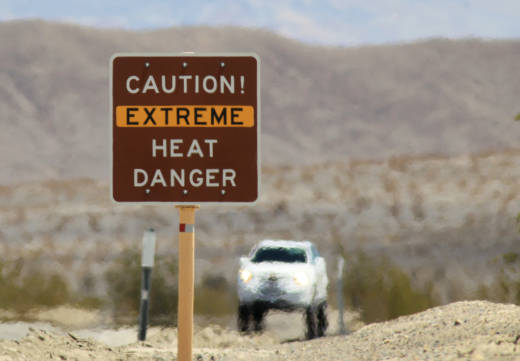“The global marketplace provides a hedge against localized extremes,” noted Noah Diffenbaugh, a Stanford climate scientist and co-author of the study, “and we’re already seeing an erosion of that climate buffer as extremes have increased in response to global warming,”
“When these extremes occur simultaneously, it exacerbates the adverse impacts beyond what any of them would have caused separately,” said Ali Sarhadi, the study’s lead author and a post-doctoral fellow at Stanford.
The study also analyzed climate projections for future scenarios. Since the late 19th century, the global temperature has increased 1.8 degrees Fahrenheit. Moving forward, the study’s authors found, in many regions the odds increase to 75 percent that average temperatures will rise well beyond the normal range experienced this last century.
It’s not just going to get hotter in the summer, though. It’s going to get warmer in the winter too — which also has lasting implications.
The other new study released this week, from the American Geophysical Union, found both relative and absolute “extreme heat” events have increased across the U.S. and Canada since 1980, while both relative and absolute extreme cold events decreased. In other words, we’ve seen a rise in both overall extremes, like the absolute hottest days in summer, but also extremes for the normal range of that time of year, like unseasonably warm days in winter.
Relative extremes are changing faster than absolute extremes. And relative extremes can pose a higher ecological risk because the out-of-season weather impact species and plants.
“Relative temperature anomalies can trigger what are called phenological mismatches, where a mismatch in the temperature and the season can cause trees to bloom too early and birds and insects to migrate before there is appropriate food,” said Scott Sheridan, professor in geography at Kent State University and lead author of the AGU study.
For example, the unusually warm month of March in 2012, across the eastern and midwestern U.S., caused vegetation to bloom prematurely and then die off in subsequent frost, leading to large agricultural losses (2012 remains the hottest year on record in the continental U.S.). Mid-winter thaws and early-season heat can also have health impacts on vulnerable populations.
Extreme heat events have increased across 79 percent of the U.S. and Canada, with the trend greatest in the southern U.S. and northern Quebec. Relative extreme heat events have increased at a greater rate, averaging .22 more days per decade, with some parts of the southern U.S. showing an increase of up to one day per decade of relative extreme heat. At the same time, extreme cold events have decreased at higher rates.
All of this comes in the wake of a federal report released last week that outlined the ways climate change is already affecting Americans’ economic and physical health. The message from the various studies’ authors? Planners and policymakers at all levels need to start preparing for the new future — and can still take steps to decrease these impacts.
The Stanford study modeled what would happen if the 200 nations in the U.N. Paris agreement achieved their emission reductions targets. The authors found that would dramatically reduce the likelihood of compounding hot, dry conditions in multiple regions.
“There are still options for mitigating these changes,” said Sarhadi.

